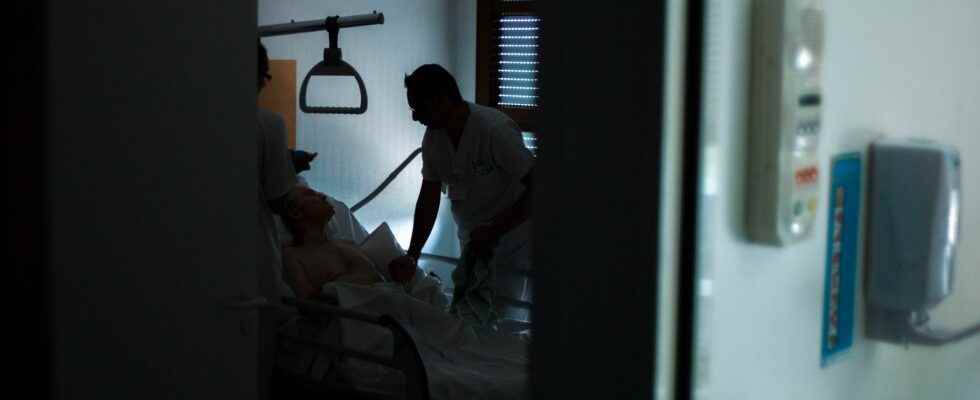Recently, a woman with incurable cancer walked through the door of Dr. Claire Fourcade’s palliative care service at the Grand Narbonne private hospital in Aude. Followed for a long time by caregivers, this patient is one of the 10 to 15% of French people who took care to write advance directives. This official document allows him in particular to express his last wishes concerning the end of his life, by continuing, limiting, stopping or refusing treatment and medical procedures.
Very weakened by the disease, the patient’s choice was clear: when the time came, she wanted deep and continuous sedation until death, in order to limit her physical suffering. “But when her condition really deteriorated, the patient changed her mind. She let the teams know that she finally wanted to keep in touch with her family for as long as possible,” says Dr. Fourcade. His relatives, they want to avoid any unnecessary pain, and argue with doctors previously written guidelines.
“However, the word of the patient, if the latter is lucid and coherent, will always take precedence over the written directives or the decisions of the family”, recalls Claire Fourcade. For doctors, a real diplomatic work then begins. “We explain to relatives, we dissect the situation… And we almost always end up unblocking things”, assures the specialist, also president of the French Society for Support and Palliative Care (SFAP). In her service, she indicates that these last-minute decisions take place “almost every day”, considered and then deconstructed according to the state of the patients. “We adapt, following the framework imposed on us by the legislation in force”. Established by the Leonetti law of 2005, and reinforced by the Claeys-Leonetti law of 2016, advance directives are defined by the Public health codewhich specifies that they “are binding on the doctor for any decision of investigation, intervention or treatment”, except in cases of “vital emergency for the time necessary for a complete evaluation of the situation” or when ‘they appear as “manifestly inappropriate or non-compliant with the medical situation”.
In such a context, and given the complexity of certain situations, debates between patients and caregivers, relatives and doctors, or even within the medical team, are “not uncommon”, says Dr. Fourcade. Latest example? An exchange with a patient who found and completed a “poorly written” advance directive form on the Internet. “He had checked that he wanted to be transfused, but not infused. It is not medically possible, and it therefore falls into the box of inappropriate directives”, illustrates the doctor. Head of the mobile support and palliative care team (EMASP) at the Rennes University Hospital, his colleague Vincent Morel confirms the existence of advance directives that are sometimes “too general”, “too vague” or “contradictory”. “If the patient explains, for example, that he ‘does not want tubes’, this effectively excludes intubation, but also the nasogastric tube for nutrition. We have to discuss, make sure that he is well aware of the consequences of his request”.
“There may be dissension”
If the doctors specializing in palliative care interviewed by L’Express indicate that “the majority of patients” are quite able to communicate their last wishes concerning their end of life, it also happens that some can no longer express themselves directly. If their directives are vague, or the family does not agree with them, then who makes the decision to carry them out or not? “It’s up to the doctor to choose, after a collegial discussion with the rest of the healthcare team and discussions with family members”, replies Michèle Lévy-Soussan, doctor in charge of EMASP at the Paris hospital in the Pitié-Salpêtrière. Sometimes the decision is difficult to make. If, for example, a patient expressed that he did not want “unreasonable therapeutic obstinacy”, how should the limits of this “obstinacy” be defined? When does care become too invasive, too heavy? “Within a team, there can be dissensus”, summarizes the doctor, also co-host of an “ethical support cell” within the establishment. “We then take the time for deliberation, we question each act, each caregiver, to find the right path to follow. We never decide on a corner of the table in a few minutes”.
In the event that relatives do not accept this medical decision, Dr Ségolène Perruchio, head of the palliative care service at the Rives de Seine hospital in Puteaux (Hauts-de-Seine), recalls that “the family will always be consulted and listened to”, but that it will “not be a decision maker”. To find a compromise, the caregiver testifies to the time spent discussing with relatives, explaining, transmitting. “Obviously we do it in lace, so that it is as less violent as possible. It’s tailor-made: if you have to leave an infusion that has no side effects for the patient in order to reassure loved ones, we do it”, she explains. But despite these precautions, the specialist admits “that it may happen that the medical decision taken is not in accordance with what the family wishes”.
In mid-November, the Constitutional Council had to rule on the situation of a patient from Valenciennes (North), plunged into a coma since May following an accident. While the medical team wanted to stop the nutrition and artificial respiration care – and thus go against the advance directives left by the patient – the family opposed this decision. Seized by relatives after several legal defeats, the Constitutional Council finally validated the legislation in force, and confirmed that a doctor is not forced to respect a patient’s advance directives. The law thus aims “to ensure the safeguard of the dignity of people at the end of life”, estimates the organization, judging the current texts sufficiently clear concerning the cases of “manifestly inappropriate” directives.
